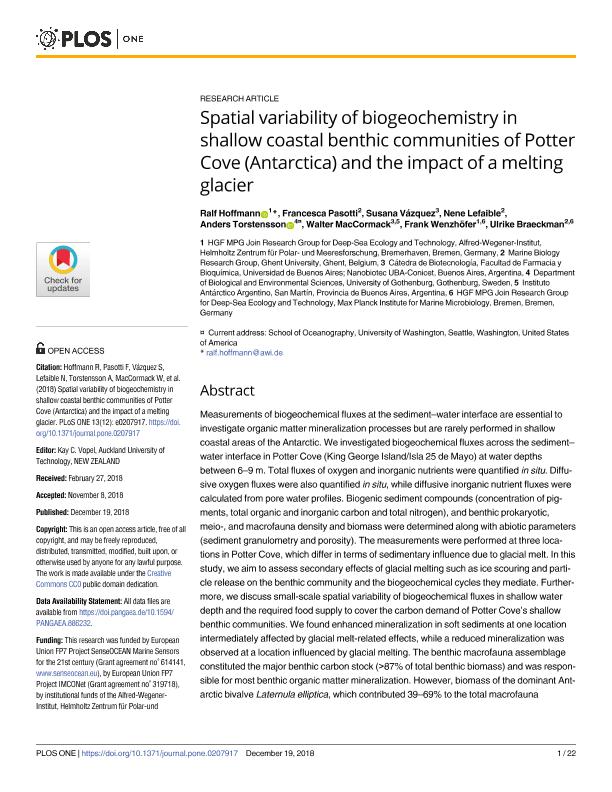Mostrar el registro sencillo del ítem
dc.contributor.author
Hoffmann, Ralf

dc.contributor.author
Passoti, Francesca
dc.contributor.author
Vázquez, Susana Claudia

dc.contributor.author
Lefaible, Nene
dc.contributor.author
Torstensson, Anders

dc.contributor.author
Mac Cormack, Walter Patricio

dc.contributor.author
Wenzhöfer, Frank
dc.contributor.author
Braeckman, Ulrike
dc.date.available
2020-01-29T17:32:34Z
dc.date.issued
2018-12
dc.identifier.citation
Hoffmann, Ralf; Passoti, Francesca; Vázquez, Susana Claudia; Lefaible, Nene; Torstensson, Anders; et al.; Spatial variability of biogeochemistry in shallow coastal benthic communities of Potter Cove (Antarctica) and the impact of a melting glacier; Public Library of Science; Plos One; 13; 12; 12-2018; 1-22
dc.identifier.issn
1932-6203
dc.identifier.uri
http://hdl.handle.net/11336/96116
dc.description.abstract
Measurements of biogeochemical fluxes at the sediment–water interface are essential to investigate organic matter mineralization processes but are rarely performed in shallow coastal areas of the Antarctic. We investigated biogeochemical fluxes across the sediment–water interface in Potter Cove (King George Island/Isla 25 de Mayo) at water depths between 6–9 m. Total fluxes of oxygen and inorganic nutrients were quantified in situ. Diffusive oxygen fluxes were also quantified in situ, while diffusive inorganic nutrient fluxes were calculated from pore water profiles. Biogenic sediment compounds (concentration of pigments, total organic and inorganic carbon and total nitrogen), and benthic prokaryotic, meio-, and macrofauna density and biomass were determined along with abiotic parameters (sediment granulometry and porosity). The measurements were performed at three locations in Potter Cove, which differ in terms of sedimentary influence due to glacial melt. In this study, we aim to assess secondary effects of glacial melting such as ice scouring and particle release on the benthic community and the biogeochemical cycles they mediate. Furthermore, we discuss small-scale spatial variability of biogeochemical fluxes in shallow water depth and the required food supply to cover the carbon demand of Potter Cove’s shallow benthic communities. We found enhanced mineralization in soft sediments at one location intermediately affected by glacial melt-related effects, while a reduced mineralization was observed at a location influenced by glacial melting. The benthic macrofauna assemblage constituted the major benthic carbon stock (>87% of total benthic biomass) and was responsible for most benthic organic matter mineralization. However, biomass of the dominant Antarctic bivalve Laternula elliptica, which contributed 39–69% to the total macrofauna.
dc.format
application/pdf
dc.language.iso
eng
dc.publisher
Public Library of Science

dc.rights
info:eu-repo/semantics/openAccess
dc.rights.uri
https://creativecommons.org/licenses/by/2.5/ar/
dc.subject
BIOGEOCHEMICAL FLUXES
dc.subject
BIOGENIC SEDIMENT COMPOUNDS
dc.subject
LATERNULA ELLIPTICA
dc.subject
BENTHIC COMMUNITIES
dc.subject.classification
Biología Marina, Limnología

dc.subject.classification
Ciencias Biológicas

dc.subject.classification
CIENCIAS NATURALES Y EXACTAS

dc.title
Spatial variability of biogeochemistry in shallow coastal benthic communities of Potter Cove (Antarctica) and the impact of a melting glacier
dc.type
info:eu-repo/semantics/article
dc.type
info:ar-repo/semantics/artículo
dc.type
info:eu-repo/semantics/publishedVersion
dc.date.updated
2019-10-11T16:06:32Z
dc.journal.volume
13
dc.journal.number
12
dc.journal.pagination
1-22
dc.journal.pais
Estados Unidos

dc.journal.ciudad
San Francisco
dc.description.fil
Fil: Hoffmann, Ralf. Alfred-Wegener-Institut, Helmholtz-Zentrum für Polar- und Meeresforschung; Alemania
dc.description.fil
Fil: Passoti, Francesca. University of Ghent; Bélgica
dc.description.fil
Fil: Vázquez, Susana Claudia. Universidad de Buenos Aires. Facultad de Farmacia y Bioquímica. Departamento de Microbiología, Inmunología y Biotecnología. Cátedra de Microbiología Industrial y Biotecnología; Argentina. Consejo Nacional de Investigaciones Científicas y Técnicas. Oficina de Coordinación Administrativa Houssay. Instituto de Nanobiotecnología. Universidad de Buenos Aires. Facultad de Farmacia y Bioquímica. Instituto de Nanobiotecnología; Argentina
dc.description.fil
Fil: Lefaible, Nene. University of Ghent; Bélgica
dc.description.fil
Fil: Torstensson, Anders. University Goteborg; Suecia
dc.description.fil
Fil: Mac Cormack, Walter Patricio. Consejo Nacional de Investigaciones Científicas y Técnicas. Oficina de Coordinación Administrativa Houssay. Instituto de Nanobiotecnología. Universidad de Buenos Aires. Facultad de Farmacia y Bioquímica. Instituto de Nanobiotecnología; Argentina. Ministerio de Relaciones Exteriores, Comercio Interno y Culto. Dirección Nacional del Antártico. Instituto Antártico Argentino; Argentina
dc.description.fil
Fil: Wenzhöfer, Frank. Alfred-Wegener-Institut, Helmholtz-Zentrum für Polar- und Meeresforschung; Alemania. Max Planck Institute for Marine Microbiology; Alemania
dc.description.fil
Fil: Braeckman, Ulrike. University Goteborg; Suecia. Max Planck Institute for Marine Microbiology; Alemania
dc.journal.title
Plos One

dc.relation.alternativeid
info:eu-repo/semantics/altIdentifier/url/https://journals.plos.org/plosone/article?id=10.1371/journal.pone.0207917
dc.relation.alternativeid
info:eu-repo/semantics/altIdentifier/doi/https://doi.org/10.1371/journal.pone.0207917
Archivos asociados
